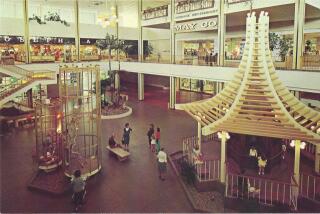Paris Seeks to Restore Glory Days of Les Halles
- Share via
PARIS — Les Halles wasn’t just a Paris neighborhood market; it was a market the size of a whole neighborhood, a labyrinth of stands and shops where you could buy oysters fresh from the coast or eat onion soup round-the-clock.
But the food lovers’ paradise was bulldozed and haphazardly rebuilt in the 1970s. Today, Les Halles is a rundown mall, a dark underground subway hub and a garden that many Parisians would never dare cross at night. The square that once fed the whole city doesn’t even have a weekly outdoor market.
So City Hall plans another dramatic transformation -- to undo the damage.
Socialist Mayor Bertrand Delanoe took office in spring 2001 promising to make Paris a cheerier and more livable city. He added bike paths and pledged to reduce vehicle traffic. In summer, he turns a highway along the Seine River into a sandy, palm-lined beach for picnics.
Les Halles is one of the next projects. There’s no blueprint yet and no budget, but teams of architects are dreaming up renovations. A winner will be chosen next year; work is to start in 2005.
The city will stop short of tearing down the shopping center, a sprawling building covered with grubby mirrors that many people complain is out of place in a neighborhood just steps from the Louvre.
Still, “it’s going to be an enormous amount of work,” Delanoe told a recent community gathering. Some goals: making the garden more welcoming, renovating the outdated mall and giving the area back a farmers’ market.
A trading center since the Middle Ages, Les Halles was a raucous place where rats ran in and out of vegetable sweepings and ladies of pleasure waited in shadowy corridors.
Emile Zola set an 1874 novel, “The Belly of Paris,” in Les Halles and described the fare in luscious detail: mountains of cabbages, coral-red carrots, a barricade of orange pumpkins.
Nearly a century later, it appeared in the Audrey Hepburn-Cary Grant suspense movie “Charade.” Hepburn strolls past bustling vendors and beef carcasses hanging from hooks.
“Charade” came out in 1963. Six years later, city officials moved the food vendors to a suburb, Rungis. Later, the city tore down the graceful old iron market pavilions despite an international protest.
“All real Parisians love this neighborhood, those who live there, those who go there to eat, or buy flowers or crates of tomatoes, or listen to an accordionist, or breathe the perfume of another era,” Le Nouvel Observateur magazine wrote in 1967.
Les Halles still has a utilitarian function. Underground, it’s the heart of the Paris and suburban public transport lines, with 800,000 commuters passing through every day. The station is connected to a mall, most of which is underground.
The mall is no one’s idea of high-class Paris shopping. There are a few big chains and movie theaters, but mostly there are shops with cheap clothing.
For visitors, the shopping center is convenient because it’s easily accessible from the trains. Unfortunately, the mall also feels something like a subway station -- dark and smelly.
The garden above ground is lively during the day with groups of tourists or young people visiting from the suburbs. At night, it’s deserted and sinister, with drug dealers quietly offering hashish to passers-by.
The grounds have evolved over the years, with designers trying to correct unsatisfying layouts. But the efforts, such as a play area for children, have broken the garden apart. Its nostalgic green trellises -- oddly paired with modern glass pyramids and fountains -- give an impression of clutter, not open space.
When Les Halles reconstruction starts, officials hope that it will be gradual, causing as little disruption as possible. Many people still grimace at the memory of “Les Halles hole” -- a pit that was the center of the neighborhood for years before the mall was finished.
With plans still up in the air, officials are consulting Parisians to find out what they want.
There are some things that they like already, such as the neighborhood’s mix of social classes and the atmosphere of relaxed neighborliness inherited from the old market days.
On a recent day, dog walkers in the garden tossed around ideas about how to spruce up the area: public toilets, more trees, more benches.
Jean-Jacques Maillard, a 25-year resident of the area, loves the neighborhood as it is, but laments the loss of the old market: “There were bistros open day and night. There were accordion players. It was Paris, you know.”
More to Read
Sign up for Essential California
The most important California stories and recommendations in your inbox every morning.
You may occasionally receive promotional content from the Los Angeles Times.










